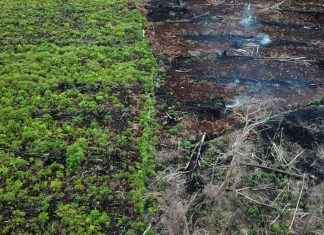They also tow away their trucks, and then retook control of the streets near the Parliament buildings.
The largest police operation in Canada’s history saw protesters retreating in a clear move of surrender. This marked the end to the three-week-old Ottawa protest against COVID-19 and the government led by Prime Minister Justin Trudeau. A few other locations in Canada saw smaller protests continue.
Steve Bell, Interim Police Chief in Ottawa, stated that although smaller protests continue, “this unlawful occupation has ended.” We will continue our mission until it is completed.”
While protesters were pledging to remain on Ottawa’s streets for the duration, one prominent organizer said that they had “decided peacefully to withdraw”.
Tom Marazzo stated at a press conference that “We will simply reconstitute as a grassroots movement.”
Bell stated that police were brought in from all over the country to assist in the clearance operation. Bell also said that 170 people were detained Friday and Saturday, and that multiple investigations had been initiated because of weapons seizures.
He said, “We’re going nowhere until you have your roads back,” at a press conference. He also promised to pursue protestors who refuse to disperse with “financial sanction and criminal charges.”
Early Saturday afternoon, protesters had left the street in front Parliament Hill. This is the collection of government offices which includes the Parliament buildings. The street had been occupied since late last month by protesters and their vehicles, becoming a carnival on weekends.
“They are trying push us all away,” declared Jeremy Glass, a protester from Shelburne, Ontario. Authorities forced the crowds further away from the Parliament buildings. “The main camp has been seized. It is now out of our hands.
According to police, protesters were still “aggressive” and aggressive and pepper spray was used to protect officers. Police also claimed that children were brought to the police stations, claiming it was “putting children at risk.”
Canadian authorities also declared that they used emergency powers in order to seize 76 accounts linked to protesters. The total amount was approximately $3.2 million ($2.5million U.S.).
They also shut down a bridge from Quebec into the capital to stop protestors returning.
Protest organizers claimed that they had directed truckers to leave Parliament Hill around midday. They also decried the actions of the police as “abuses” of power.
“Moving the trucks will take time,” organizers stated in a statement. “We hope (police will) show judicious restraint.”
Ottawa police had earlier tweeted that they addressed protesters and said, “We told you leave. We gave you plenty of time to leave. While we were methodical and slow, you were aggressive and aggressive towards officers and horses. We are taking action based on your behavior and adding helmets to our safety.
One protester was said to have thrown a gas canister at police and was taken into custody as they moved.
Bell stated earlier that most arrests were made for mischief and that no protesters were injured. He said that one officer sustained a minor injury.
Four protest leaders were among those who were arrested. One was released on bail, while the other three were still in jail.
Police escort arrived at the scene and began removing hundreds of large rigs, campers, and other vehicles that were parked near Parliament. Police broke through at least one camper’s door Friday, before taking it away.
The crackdown against the Freedom Convoy started Friday morning when hundreds of police officers, some in riot gear, and others with automatic weapons, entered the protest zone. They began leading protestors away in handcuffs along the snowy streets, while truckers holding out their horns.
After weeks of protests and blockades that closed border crossings to the U.S., the capital and its paralyzed streets were the movement’s last stronghold. Trudeau was now facing one of the most difficult tests yet. Some blame America’s influence, while others questioned Canada’s civility.
The Freedom Convoy protests were initially focused on Canada’s requirement that truckers enter the country with vaccinated drivers. However, they quickly morphed into an attack on COVID-19 precautions as well as Trudeau’s government.
Ottawa residents complained about being intimidated and harassed by truckers. They obtained a court order to stop their incessant honking.
Trudeau described the protesters in a “fringe” manner. Canadians have generally accepted the COVID-19 regulations, with nearly all of them vaccinated. This includes an estimated 90% Canadian truckers. Some of the mandates for vaccines and masks that were imposed by the provincial governments are rapidly falling away.
The largest border blockade was at the Ambassador Bridge, Windsor, Ontario and Detroit. It stopped the flow of parts between the two countries, and forced the industry into a halt in production. After dozens of protesters were arrested, authorities lifted the siege.
Even as Ottawa was becoming calmer, the Canadian border agency advised that the operation at the key truck crossing from Canada to the United States had been slowed down by protesters. They recommended that travelers find another route. Officials said that the crossing was still open near Surrey, but they were unable to provide further information.
Protests were cheered and have received donations from conservatives in America.






